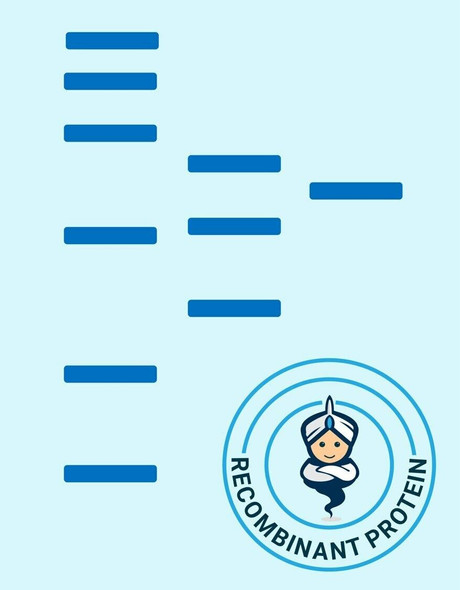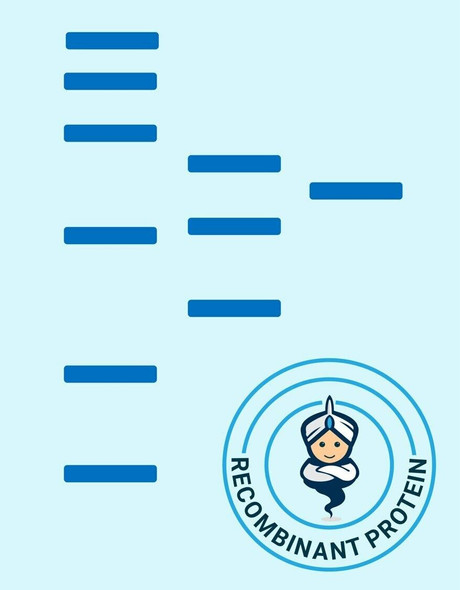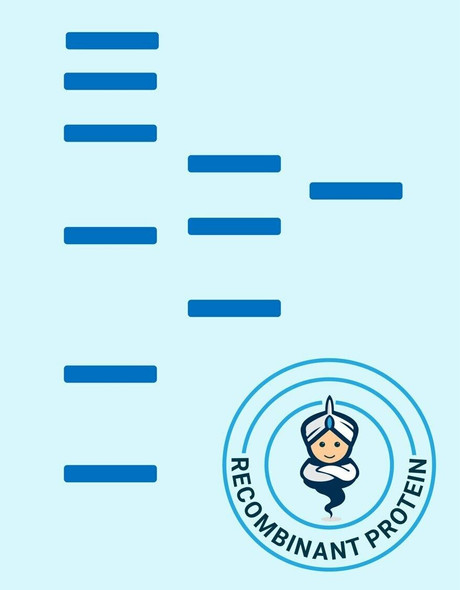Human FGFR4 Recombinant Protein (RPPB2522)
- SKU:
- RPPB2522
- Product type:
- Recombinant Protein
- Size:
- 10ug
- Species:
- Human
- Target:
- FGFR4
- Synonyms:
- Fibroblast Growth Factor Receptor 4
- EC 27101
- JTK2
- TKF
- Source:
- Insect Cells
- Uniprot:
- P22455
Description
| Product Name: | Human FGFR4 Recombinant Protein |
| Product Code: | RPPB2522 |
| Size: | 10µg |
| Species: | Human |
| Target: | FGFR4 |
| Synonyms: | Fibroblast Growth Factor Receptor 4, EC 2.7.10.1, JTK2, TKF, Tyrosine Kinase Related To Fibroblast Growth Factor Receptor, Hydroxyaryl-Protein Kinase, Protein-Tyrosine Kinase, Tyrosylprotein Kinase, CD334 Antigen, EC 2.7.10, FGFR-4, CD334, FGFR4. |
| Source: | Insect Cells |
| Physical Appearance: | Sterile Filtered White lyophilized (freeze-dried) powder. |
| Formulation: | CD334 was lyophilized from a concentrated (1mg/ml) sterile solution containing no additives. |
| Solubility: | It is recommended to reconstitute the lyophilized FGFR-4 in sterile PBS not less than 100 µg/ml, which can then be further diluted to other aqueous solutions. |
| Stability: | Lyophilized FGFR4 although stable at room temperature for 3 weeks, should be stored desiccated below -18°C. Upon reconstitution FGFR4 should be stored at 4°C between 2-7 days and for future use below -18°C.For long term storage it is recommended to add a carrier protein (0.1% HSA or BSA).Please prevent freeze-thaw cycles. |
| Purity: | Greater than 90.0% as determined by:(a) Analysis by RP-HPLC.(b) Analysis by SDS-PAGE. |
| Biological Activity: | Determined by its ability to inhibit human FGF acidic-dependent proliferation on R1 cells. The ED50 for this effect is typically at 15.0-30.0 ng/ml. |
Fibroblast growth factors (FGFs) comprise a family of at least eighteen structurally related proteins that are involved in a multitude of physiological and pathological cellular processes, including cell growth, differentiation, angiogenesis, wound healing and tumorgenesis. The biological activities of the FGFs are mediated by a family of type I transmembrane tyrosine kinases which undergo dimerization and autophosphorylation after ligand binding. Four distinct genes encoding closely related FGF receptors, FGF R1 - 4, are known. All four genes for FGF Rs encode proteins with an N-terminal signal peptide, three immunoglobulin (Ig)-like domains, an acid-box region containing a run of acidic residues between the IgI and IgII domains, a transmembrane domain and the split tyrosine-kinase domain. Multiple forms of FGF R1 - 3 are generated by alternative splicing of the mRNAs. A frequent splicing event involving FGF R1 and 2 results in receptors containing all three Ig domains, referred to as the a isoform, or only IgII and IgIII, referred to as the b isoform. Only the a isoform has been identified for FGF R3 and FGF R4. Additional splicing events for FGF R1 - 3, involving the C-terminal half of the IgIII domain encoded by two mutually exclusive alternative exons, generate FGF receptors with alternative IgIII domains (IIIb and IIIc). A IIIa isoform which is a secreted FGF binding protein containing only the N-terminal half of the IgIII domain plus some intron sequences has also been reported for FGF R1. Mutations in FGF R1 - 3 have been found in patients with birth defects involving craniosynostosis. The complex patterns of expression of these receptors as well as the specificity of their interactions with the various FGF ligand family members are under investigation.
Soluble FGFR-4a (IIIc) Fc Chimera Human Recombinant fused with Xa cleavage site with the Fc part of human IgG1 produced in baculovirus is a heterodimeric, glycosylated, Polypeptide chain and having a molecular mass of 170 kDa. The FGFR4 is purified by proprietary chromatographic techniques.
| UniProt Protein Function: | FGFR4: a tyrosine-kinase receptor that acts as cell-surface receptor for fibroblast growth factors and plays a role in the regulation of cell proliferation, differentiation and migration, and in regulation of lipid metabolism, bile acid biosynthesis, glucose uptake, vitamin D metabolism and phosphate homeostasis. Required for normal down-regulation of the expression of CYP7A1, the rate-limiting enzyme in bile acid synthesis, in response to FGF19. Phosphorylates PLCG1 and FRS2. Ligand binding leads to the activation of several signaling cascades. Activation of PLCG1 leads to the production of the cellular signaling molecules diacylglycerol and inositol 1,4,5-trisphosphate. Phosphorylation of FRS2 triggers recruitment of GRB2, GAB1, PIK3R1 and SOS1, and mediates activation of the MAP kinase and AKT signaling pathways. Promotes SRC-dependent phosphorylation of the matrix protease MMP14 and its lysosomal degradation. FGFR4 signaling is down-regulated by receptor internalization and degradation; MMP14 promotes internalization and degradation of FGFR4. Mutations that lead to constitutive kinase activation or impair normal FGFR4 inactivation lead to aberrant signaling. Two isoforms of the human protein are formed by alternative splicing. This description may include information from UniProtKB |
| UniProt Protein Details: | Protein type:Kinase, protein; EC 2.7.10.1; Protein kinase, tyrosine (receptor); Protein kinase, TK; Membrane protein, integral; TK group; FGFR family Chromosomal Location of Human Ortholog: 5q35.2 Cellular Component: cytoplasm; endoplasmic reticulum; endosome; extracellular region; Golgi apparatus; integral to plasma membrane; intercellular junction; nucleoplasm; plasma membrane; transport vesicle Molecular Function:ATP binding; fibroblast growth factor binding; fibroblast growth factor receptor activity; heparin binding; protein binding; protein-tyrosine kinase activity Biological Process: activation of MAPKK activity; axon guidance; cell migration; epidermal growth factor receptor signaling pathway; fibroblast growth factor receptor signaling pathway; glucose homeostasis; innate immune response; insulin receptor signaling pathway; MAPKKK cascade; nerve growth factor receptor signaling pathway; peptidyl-tyrosine phosphorylation; phosphate ion homeostasis; phosphoinositide-mediated signaling; positive regulation of cell proliferation; positive regulation of metalloenzyme activity; positive regulation of proteolysis; protein amino acid autophosphorylation; Ras protein signal transduction; regulation of lipid metabolic process; small GTPase mediated signal transduction; vascular endothelial growth factor receptor signaling pathway |
| NCBI Summary: | The protein encoded by this gene is a member of the fibroblast growth factor receptor family, where amino acid sequence is highly conserved between members and throughout evolution. FGFR family members differ from one another in their ligand affinities and tissue distribution. A full-length representative protein would consist of an extracellular region, composed of three immunoglobulin-like domains, a single hydrophobic membrane-spanning segment and a cytoplasmic tyrosine kinase domain. The extracellular portion of the protein interacts with fibroblast growth factors, setting in motion a cascade of downstream signals, ultimately influencing mitogenesis and differentiation. The genomic organization of this gene, compared to members 1-3, encompasses 18 exons rather than 19 or 20. Although alternative splicing has been observed, there is no evidence that the C-terminal half of the IgIII domain of this protein varies between three alternate forms, as indicated for members 1-3. This particular family member preferentially binds acidic fibroblast growth factor and, although its specific function is unknown, it is overexpressed in gynecological tumor samples, suggesting a role in breast and ovarian tumorigenesis. [provided by RefSeq, Jul 2008] |
| UniProt Code: | P22455 |
| NCBI GenInfo Identifier: | 13432140 |
| NCBI Gene ID: | 2264 |
| NCBI Accession: | P22455.2 |
| UniProt Secondary Accession: | P22455,O43785, Q14309, Q71TW8, Q8TDA0, Q96KE5, G3JVM2 G3JVM5, G3JVM7, G3JVM9, |
| UniProt Related Accession: | P22455,AAB25788 |
| Molecular Weight: | 64,640 Da |
| NCBI Full Name: | Fibroblast growth factor receptor 4 |
| NCBI Synonym Full Names: | fibroblast growth factor receptor 4 |
| NCBI Official Symbol: | FGFR4 |
| NCBI Official Synonym Symbols: | TKF; JTK2; CD334 |
| NCBI Protein Information: | fibroblast growth factor receptor 4 |
| UniProt Protein Name: | Fibroblast growth factor receptor 4 |
| UniProt Synonym Protein Names: | CD_antigen: CD334 |
| Protein Family: | Fibroblast growth factor receptor |
| UniProt Gene Name: | FGFR4 |
| UniProt Entry Name: | FGFR4_HUMAN |









